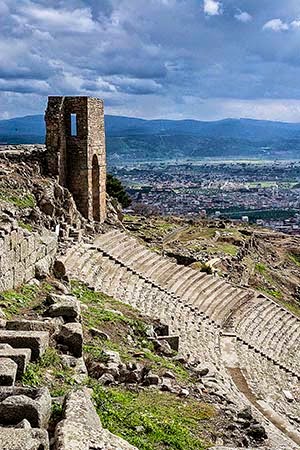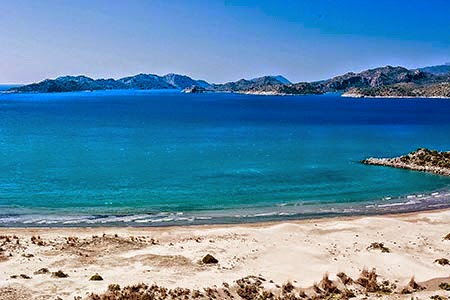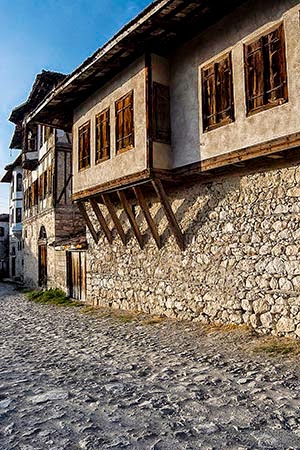Kaleiçi – Castle of Antalya
 |
| Lost in Kaleiçi |
This post is about two of
the reasons for visiting Antalya: the Old City of Kaleiçi, with its gorgeous Ottoman houses, and food. We had just finished our morning at the Antalya Archaeological Museum described in our last post and
we're finally driving to our hotel.
Kaleiçi means “within the castle” but today this was more
like the road to hell. I did not have a
paper map because I was relying on the old technique of “offline” Google map of
Kaleiçi and, of all days, it disappeared from my tablet. Antalya has the worst signs and there was no
tourist office. Doesn’t the city realize
that there are tourists who are driving in their city?
 |
| Kaleiçi Caddesi |
 |
| Our Room in the White Garden |
It had taken two hours trying to find our hotel, the White Garden
Pansion, a gorgeous 125 year old Ottoman house. The photo shows our room, which has the oriel
window that juts out over the street.
In
terms of architecture this was one of the special places we stayed at in
Turkey. It was a pleasure to sit in the
dining room each morning and have the typical Turkish breakfast surrounded by
beautiful wood ceilings and green outdoor garden outside the glass wall.
 |
| Outstanding Ottoman Houses |
We still hadn't eaten so we walked through Kaleiçi along
Hespaçi Sokak bypassing the more expensive tourist restaurants toward the place
we were going to try out. There were some touts
– though not as bad as Istanbul asking you to buy at their shop. We just ignored them. There were many examples of stone and timber-framed Ottoman
architecture. This was definitely a
larger and more affluent Ottoman area than two places described in our Cumalikizik
& Bursa – Ottoman Delight post.
 |
| Hadrian's Gate |
Finally we reached Hadrian's Gate, which was erected to commemorate
his visit in 130 CE, but was not built by Emperor Hadrian – who did
complete the Temple
of Trajan in Precipitous Pergamon.
Üçkapılar (its Turkish name) means three arches.
This typical Roman triumphal gate is built
entirely of white marble, which contrasts with the brown adjoining towers. It is amazing that cart wheels could have
carved the deep grooves in the stone pavement beneath the central arch.
 |
| Tea anyone? |
Once we
exited the old city through Hadrian's Gate onto
Ataturk Blvd, it was another world of Antalyans shopping and talking.
There
were lots of young people in very modern clothes. A çaycı (Turkish tea waiter) circulates the
small wall-side park selling tea. The
word çay (pronounced chai) comes from Hindi chai, where their
word and the tea originated.
 |
| Kaleiçi Kafe |
We walked on Recip Peker Cd two blocks then turned right
to Arik Cd 4 to find the non-descript Can Can Pide ve Kebab Salonu. We had a
late lunch of two yummy mercimek çorbası
(lentil) soups, one pide (type of
pizza), and two teas. I still think the
pide in Toronto is better. Even though
we were only a couple of blocks away from Kaleiçi, there were no tourists. We shared the table with the locals. That meal cost TRY 17 for both of us! In the tourist area the mains alone were TRY
20 ($10) each!!!
 |
| Wedding Photo Shoot |
I also
became a wedding photographer today. I
was walking down the narrow alleys and came upon a shocking sight. A Turkish couple all dressed up and making
dramatic poses. They were so cute
and really seemed to be enjoying their photo shoot.
I even photographed the wedding photographer as she was wearing special outfit as well.
 |
| Capturing the Photographer |
After that we walked to the clock tower – wow, this is
where the locals were hanging out. Then
we walked back via Uzun Çarşı Sokak. We
were nearly back – I think it was around Kaledibi Sokak – when I saw a sign for
sahlep TRY 3. As mentioned in the Topkapi Palace
Paradise post, the aromatic sahlep drink is made from wild orchid
root, milk, honey, cinnamon and vanilla – and it is yummy! I could have had a second cup.
Because that very late lunch was filling, we never did have
supper. We went back to the pension but sat downstairs in the Ottoman lobby
where there are divans and sofas and had tea (just ask the desk) and talked
with the concierge.
 |
| Hidirlik Tower |
Kaleiçi Day 2
It was a glorious sunny day. We went to the Ancient Roman Hıdırlık Tower at
the end of Hespaçi Sokak.
We discovered the extensive Karaalioglu Park along the sea with fabulous views of the snow-capped Taurus Mountains across the bay. So that’s why people like it here.
 |
| Taurus Mountains |
We discovered the extensive Karaalioglu Park along the sea with fabulous views of the snow-capped Taurus Mountains across the bay. So that’s why people like it here.
 |
| Our Oldest Breakfast Table |
We returned to our hotel for breakfast in the Ottoman
foyer. In summer everyone goes outside
to eat in the inner courtyard. In the
mornings we talked with the owner, Metin, and especially his very helpful
nephew who was working the reception at the hotel. Breakfast consisted of fresh fruit, cereal,
cooked meats and cheese, and very good coffee.
 |
| The Youngest Tourist |
At breakfast, we met the cutest Dutch girl who had a gorgeous smile, and loves football (soccer). Unfortunately, she didn't talk very much – but you cannot have everything. She is only 14 months old!!!
Next Post: Stupendous Aspendos and Köprülü Kanyon
Last Post: Antalya Archaeology Museum






































